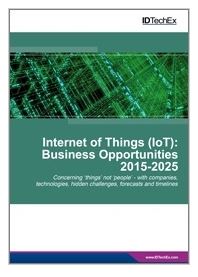The new IDTechEx report, Internet of Things (IoT): Business Opportunities 2015-2025 is unique in being up-to-date and very thorough in examining the challenges not just the opportunities for this hyped subject. The Internet of People is very different: a renaming of the world of smart phones and other internet-enabled personal electronics, it is maturing but adding wearable personal devices and many new human interfaces. By contrast, the Internet of Things (IoT) centers on things collaborating with things without human intervention at the time. These things have internet protocol (IP) addresses, microcontrollers for local data processing and they sense. However, few exist as yet since the low costs, large number of available IP addresses, widely available internet access and other factors necessary for their success have only recently become available. Indeed many, previously ignored inhibiting factors that we identify have yet to be tackled seriously.

The whole picture
Will the small IoT projects fulfilled by small businesses today give way to huge projects on the wish lists of large corporations? For the first time, we find lessons from the past and give the results of many new interviews and discussions at recent events. These often reveal a very different picture from the unquestioning enthusiasm in company publicity and in reports by some other researchers. We share the experience of our technology analysts who travel intensively to find the latest situation.
In this report, we carefully appraise what should sensibly be called Internet of Things (IoT) nowadays and how it fits into the Internet of Everything, avoiding the common practice of renaming many other things to boost the figures. We consider the reasons why the technology and market first called Internet of Things failed to live up to its promise after 15 years, with big companies moving to other pastures. It was minimally related to the original dreams of embedded computing disappearing into the fabric of society. Other errors are to some extent being repeated with today’s IoT, partly because different players are involved and, “Those that do not study history are doomed to repeat it”.
These networks are close to the original dream of “Things that Think”. We also assess and, in many cases, forecast for ten years ahead the allied markets such as Radio Frequency Identification (RFID), traditional sensing systems, body area networks, mesh networks that are not currently IoT such as ZigBee networks, many of these options connecting to the internet only via backhaul. There are two reasons for examining networks that are not IoT. These other technologies are often perfectly good ways of fulfilling certain needs without recourse to IoT and, on the other hand, some are potential targets for conversion to IoT. In addition, many key enabling technologies for IoT are analysed for these promise disruptive change with such things as flexible, stretchable electronics that harvests energy, invisibility and ultra-low cost and small size from printing.
Market potential and investment opportunities
Many potential applicational areas for IoT are appraised. For example, we give ten year forecasts for wearable electronics because it will become a substantial IoT territory.
We exemplify the excellent investment climate including large companies overpaying for small ones in some cases. The report ends with those revealing interviews we have carried out and our view of the meetings we have attended across the world recently, though our earlier experience is, of course, also brought to bear in our analysis.
We assess the realistic potential for today’s IoT and give forecasts. Over the next few years, IoT will mainly consist of a large number of small projects carried out by small to medium businesses. It will become a large business providing significant income for all sizes of supplier but later than most people think because so much work needs to be done. Large potential customers must be found. The IoT tipping point is therefore tough to predict. It is certainly not imminent but the potential is huge, being likely to reach tens of billions of cut-price nodes yearly, that income being exceeded by the potential for systems, services and software.
Advertisement
Learn more about IDTechEx





